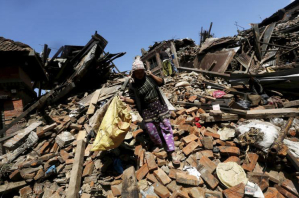
The death toll from the Nepal earthquake has gone above 5,200, and those left homeless in its aftermath desperately need tents and other supplies.
According to Manesh Shrestha, Jethro Mullen and Laura Smith-Spark of CNN, a government minister in Nepal indicated on Wednesday that the country would need 500,000 tents for those made homeless by the earthquake. Minendra Rijal, Nepal's minister of information and communications, acknowledged the current relief efforts but thought more needed to be done.
"Life is returning to normal, but it will be some time to be completely normal," Rijal said. "We have still not been able to properly manage to provide relief."
Rijal was unable to tell CNN the precise number of homeless across Nepal in the quake's aftermath. However, he stated that the government has been able to provide more than 4,700 tents and 22,000 tarpaulins to those who needed shelter.
"Aircraft loaded with tents are expected from India and Thailand in the next day, he said, with another 100,000 tents expected from Pakistan," Shrestha, Mullen and Spark wrote.
According to the United Nations, the quake has affected 8 million people across 39 districts; one-fourth of them lived in the worst affected areas. UNICEF, the U.N. children's agency, told CNN that 1.7 million children are in urgent need of aid now; it launched a $50 million appeal to get help to them.
"The lives of so many children have been torn apart and they are in desperate need of life-saving support, including clean water, shelter and sanitation," UNICEF Nepal representative Tomoo Hozumi said.
Hozumi added that "a safe water supply" was needed to prevent the spread of "waterborne diseases" in children.
"Many families are struggling simply to protect themselves from the sun and rain, and we only expect needs to grow in the coming days," Hozumi said.
According to Jason Burke of the Guardian, the epicenter of Saturday's earthquake came from the Gorkha district of Nepal. More than 10,000 people live in that area, and their status is unknown due to the remoteness of the location.
"There are 2,000 families living in this area, which means around 10,000 or 11,000 people. There is no electricity, no phone, no means of transport [there]," Dhruba Devkota, project manager of Save the Children, said.
Burke reported that 90 percent of schools and 80 percent of health facilities have been rendered unusable in the Gorkha district, which has a population around 350,000. Some information has been transmitted to the outside world thanks to satellite phones carried by two groups of mostly French trekkers hiking near the world's eighth highest peak, Manaslu.
"We know there have been some big landslides but we have very little information, and none from some parts. These people cannot be reached," senior Gorkha government official Uddab Prasad Timilsina said.
Despite the criticism directed at the slow progress of aid efforts, Timilsina told Burke that the accusations were unfair, given the magnitude of the situation.
"We are doing our best," Timilsina said. "We are working 18 hours a day."
The U.S. government agency USAID has provided a suggested list of nongovernmental organizations that can accept donations aimed to help those displaced by Nepal's earthquake.







